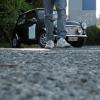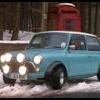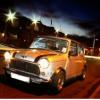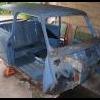
Minispares Wheel Bearings Genuine Vs Non Genuine
#1

Posted 18 August 2012 - 01:44 PM
False economy to buy the cheaper ones? Minispares appear to be a good reputable supplier, so maybe the non genuine are fine?
#2

Posted 18 August 2012 - 01:48 PM
#3

Posted 18 August 2012 - 02:23 PM
Fitted genuine ones from minispares and they have been in over a year now without problem.
Regards
Steve
#4

Posted 18 August 2012 - 02:30 PM
Timken bearings are best, but be careful that they really are Timken. Look for signs of bad translation from Chinese on the box. The market is flooded with defective Chinese parts, and they are even getting into the aircraft and nuclear industries. They are usually spotted before any harm is done, but it is a constant worry.
#5

Posted 18 August 2012 - 02:32 PM
#6

Posted 18 August 2012 - 02:46 PM
#7

Posted 18 August 2012 - 08:14 PM
#8

Posted 18 August 2012 - 09:13 PM
Hub off job I assume?? ( new to all this
#9

Posted 18 August 2012 - 09:34 PM
How hard is it to replace bearings?? Front one?
Hub off job I assume?? ( new to all this)
some good guides out there
http://www.myminiproject.co.uk/lucy/mini19.html
http://www.mra-minis.co.uk/c/knowledge-base/classic-mini/drivetrain/fitting-wheel-bearings-cv-split-cone-washer-and-drive-flange.htm
I am gonna get my hands dirty on this one. Got a garage, git the gear, got the time, got TMF. What can go wrong
#10

Posted 18 August 2012 - 09:36 PM
I did my swivel joints but I think theres slight play in the bearing
Ill savethe guides
#11

Posted 19 August 2012 - 08:25 AM
The bearings must ALWAYS be replaced in pairs, i.e. both bearings in the same hub, because they are supplied as a matched set, with spacer if needed, so that the running clearances are correct. Never mix parts of one set with another.
But if you mean do you have to replace left and right together, well I generally do as both will have about the same amount of wear in normal road use, but there may be odd occasions where something like the wheel being kerbed, or racing around the circuit in one direction continuously, has put very unequal load on the bearings such that only one side is worn. My old City E had a badly manufactured hub flange on one side and chewed the bearings, as well as pulling badly to the left as soon as it warmed up, so I changed the flange and bearings on that side only. But next time around, at a very much higher mileage, I changed them both.
#12

Posted 19 August 2012 - 01:08 PM
minisilverbullet,
The bearings must ALWAYS be replaced in pairs, i.e. both bearings in the same hub, because they are supplied as a matched set, with spacer if needed, so that the running clearances are correct. Never mix parts of one set with another.
But if you mean do you have to replace left and right together, well I generally do as both will have about the same amount of wear in normal road use, but there may be odd occasions where something like the wheel being kerbed, or racing around the circuit in one direction continuously, has put very unequal load on the bearings such that only one side is worn. My old City E had a badly manufactured hub flange on one side and chewed the bearings, as well as pulling badly to the left as soon as it warmed up, so I changed the flange and bearings on that side only. But next time around, at a very much higher mileage, I changed them both.
Yeah sorry meant on each wheel.
#13

Posted 19 August 2012 - 01:21 PM
Also make sure to use the proper bearing seating washer when assembling. This will make sure that everything sits square. The washer is basically the same as the one with the drive shaft except that it doesn't have the split in it so can't change shape when pressure is applied.
Have a look at this thread on 16v
http://www.16vminicl...ead.php?t=29036
If you find you go through a set quickly it may be a sign that you have a warped hub. I had this on an escort.
#14

Posted 27 February 2014 - 08:17 PM
I am amazed by these comments! Now I don't have a Mini anymore but I have made several trailers that use Mini rear bearings. Incidentally there are two types of bearing, the basic type has two ball-races and a steel spacer tube. With this type the spindle nut needs to be tightened well-hard. The other type as used on the Mini Coopers are taper-roller bearings. No spacer tube is used. Instead the bearings are nipped-up until they drag slightly. The spindle nut is then backed-off until the drag ceases and the split pin is then put into the nearest hole.
The hubs will carry about 500 kilos the pair. They will carry more but the weak point is loosening of the wheel nuts especially on the left hand side. The easiest solution is to fit slightly longer studs that will allow 3/8" UNF Nylock nuts to be put on top of the wheel nuts. There is not enough metal in the OEM hubs to fit thicker studs so the lock-nut method is the best solution. If one sticks to 10" wheels it is possible to buy 6 ply rated and even 8 ply rated tyres in order to carry more weight but the wheel nuts loosening are the weak point. Thread-lock or even Superglue will however get you home in an emergency.
I have NEVER EVER had wheel bearing failure which has to show that the design was OK. I do however use Extreme Pressure wheel bearing grease which is as cheap as chips at the farmers supply store. Maybe the people with failing bearings are driving their cars very hard indeed, on two wheels perhaps? (I do know that from my soap-box cart days that it is hard cornering and not the weight that destroys the wheels!)
Allegedly there are now some poor quality wheel studs out there. The proper ones used to have a trade mark and "10.9" stamped on their heads. If you are offered unmarked studs it might be a good idea to walk away as unmarked studs and bolts normally have a Property Rating (strength rating) of 4.4 Take care!
#15

Posted 27 February 2014 - 10:36 PM
Complete and utter guff, almost all incorrect, and dangerous. ALL Mini rear hubs are designed to be torqued up fully, with either a spacer, specifically matched to the bearing pair with which it is supplied, or a pair of matched bearings with extended inner races, which achieve the same thing with no spacer, and again must be used as a pair. READ THE MANUAL! There have been far too many instances on this forum of defective and counterfeit bearings being supplied which lock up before the nut is torqued up. Once the bearing has been overloaded in that way, it is scrap anyway.
If the Mini hub is used without the nut being fully torqued up, the bearing retention and locking by the split pin only is insufficient. Adjustable taper roller bearings certainly exist, for instance on the front wheels of most older RWD cars, however they differ substantially in the design of the washer, with at the very least a groove in the shaft and an anti-rotation lug in the bore of the washer, so that the split pin is never exposed to frictional torque from the bearing.
If Mini hubs are used, correct way round, left hand thread on left hand wheel, there is a very real risk of split pin fracture, followed by the nut winding itself up tight, followed by rapid overheating and failure of the stub axle. Wrong way round, the nut will come off, followed by the wheel.
Not only that, but putting Nyloks on top of the wheel nuts is extremely bad practice. Do you know, or think that you know, which threads will actually be carrying the load, and what the likely consequences will be? No, I thought not....
It is just plain illegal and dangerous to use a wheel and hub combination beyond its DESIGNED load capability.
And, almost every bearing failure seen on this forum has been caused by incorrect fitting, bogus or defective parts, kerbing, or just plain old high mileage wearout. I doubt that many have been caused by energetic driving, as the rear wheel bearings are generally robust, or were until the dangerous Chinese trash flooded the market. Over 200k miles is possible on a standard set of rear hubs.
The wheel studs are almost always 8.8, and you are extremely unlikely to find one that is 4.4, except again a bogus Chinese part, where 4.4 probably equates to a genuine 2.2, something like cheese. There is not much point in using 10.9, as they are less ductile and more likely to suffer fatigue failure than 8.8, and 12.9 would be very much worse in that regard. The fatigue threshold of steel does not increase as the static tensile strength increases, in fact it tends to decrease slightly, so in conditions of high dynamic load a very high grade material is inappropriate.
By the way, unscrupulous cowboys frequently sell "Mini" steel wheels allegedly suitable for trailers, that are in fact golf cart wheels. sadly, I think that a few may have found their way on to real Minis. Sooner or later, someone will be killed as a result of that, just as people were killed by agricultural tyres being sold for road use a few years back.
1 user(s) are reading this topic
0 members, 1 guests, 0 anonymous users

















